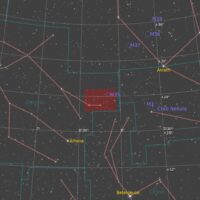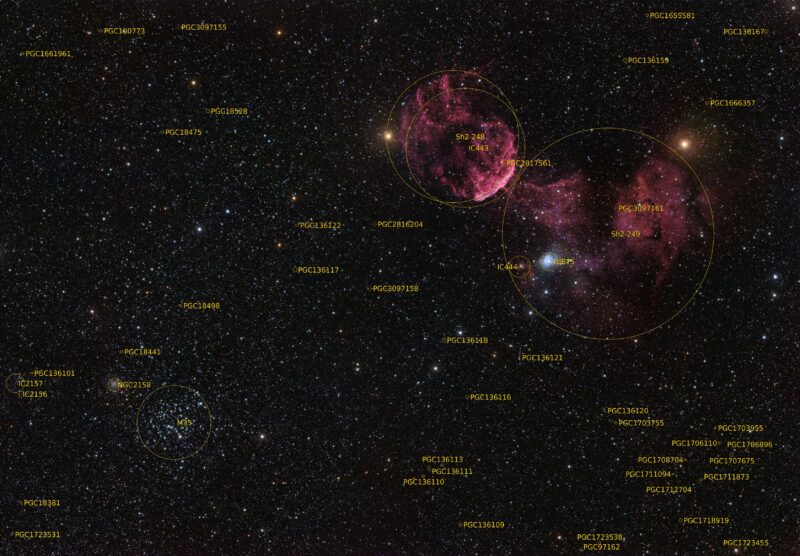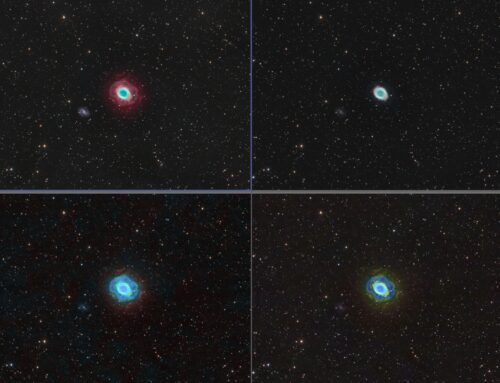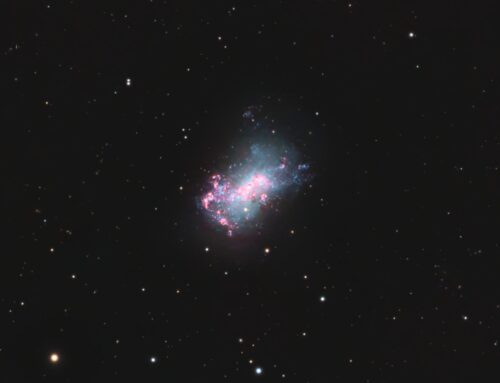IC 443 Wide Field
 Click image for full size version
Click image for full size version
Janauary 28, 2024
This IC 443 wide-field image shows the celestial jellyfish swimming more or less upside down in the upper right of this image. The jellyfish is IC 443, a remnant of a supernova explosion (exploding large star) in our galaxy thought to have occurred 3,000 – 30,000 years ago. It’s about 5,000 light years away. Below and to its right is a large dim emission nebula, Sh2-249, a member of the Sharpless catalogue about 5,200 light years distant. The blue-tinged reflection nebula beneath the jellyfish is vdB 75also 5,200 light years away. This entire field lies within the constellation of Gemini.
The lower left of this photo is dominated by two star clusters. M35 is the larger of the two, covering an area almost the size of the full moon. M35 is about 2,800 light years distant. To its upper left is NGC 2158, a similar star cluster that lies much further away, at 11,000 light years away. The redness of NGC 2158 is mostly due to its age of around 2 billion years; M35 is much younger and still contains many hot blue and white stars. Both of these objects are known as open clusters (or galactic clusters). This type of star cluster gives a knotty appearance to the Milky Way and the arms of other spiral galaxies, like M33. You can find a higher resolution image of M35 and NGC 2158 here.
There are numerous other catalogued objects in this shot, including a few small nebula like IC 444 and dozens of distant galaxies. I prepared an annotated image to help you navigate this busy field.
Tekkies:
Takahashi FS-60CB scope with flattener at f/6.2 and QHY367C Pro one-shot colour camera with Optolong L-Quad Enhance Filter. Paramount MX, unguided. Equipment control with N.I.N.A. and PHD2. All pre-processing and processing in PixInsight. Acquired from my SkyShed in Guelph December 14-15, 2023. Average transparency and seeing, and little Moon.
85 x 5m OSC = 7hr05m
Preprocessing: The WeightedBatchPreProcessing script was used to perform calibration, cosmetic correction, weighting, registration, local normalization, integration and Drizzle integration of all frames (CFA Drizzle checked, Scale=2x, Drop Shrink=0.9).
Gradient Removal: GraXpert was applied to the OSC master.
Colour Calibration: ColorCalibration was used to calibrate the OSC master.
Deconvolution: BlurXterminator was applied using an automatic PSF, star sharpening set to 0.10, and “Correct First” selected.
Star Removal: StarXterminator was used to remove the stars, with Unscreen selected.
Linear Noise Reduction: NoiseXterminator was applied with Amount=0.95 and Detail=0.35
Stretching: HistogramTransformation was applied to make a pleasing yet bright image. Approximate background level after stretch was 0.10
Nonlinear Processing
Nonlinear Noise Reduction: NoiseXterminator was applied with Amount=0.9 and Detail=0.15
Supplemental Stretching: HistogramTransformation was used to adjust the black point and increase brightness and contrast. Approximate background level after stretch was 0.10
Contrast Enhancement: Using a mask to select the nebulae, LocalHistogramEqualization was applied twice. A Contrast Limit of 1.5 and 1 iteration was used for each LHE application (scale 35, strength 0.35; scale 125, strength 0.30).
Sharpening: The same mask was used with MultiscaleMedianTransform to sharpen Layers 1 – 4 with strengths of 0.01, 0.03, 0.03, and 0.02, respectively.
Nebula Enhancement: The EnhanceNebula script was used to enhance a clone of the image, which was blended back into the original at 1:1 through the same mask used for LHE.
Stars-only steps: The stars-only image was stretched with HistogramTransformation. The stretch was slightly less aggressive than the sreen transfer function determined automatically by StarXterminator. CurvesTransformation CIE c* (colourfulness) slider was used to add colour saturation to the stars through a mask made by extracting the Luminance from the stretched stars-only image.
Star Restoration: PixelMath expression combine(starless, stars, op_screen()) was used to combine the starless and stars-only images created with StarXterminator.
Final Steps: Background, nebula and star brightness, contrast and saturation were adjusted in several iterations using CurvesTransformation with masks as required. The image was down-sampled by a factor of 2, which restored it to the original resolution. ICCProfileTransformation (sRGB IEC61966-2.1; Relative Colorimetric with black point compensation) was applied prior to saving as a jpg. The image was annotated with the AnnotateImage script. The finder chart was made using the FindingChart process.








Leave A Comment